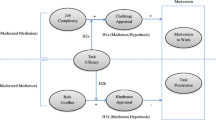Abstract
The ability to take personal control of stressors may help reduce the effects of stress. The purpose of this study is to investigate whether the use of two stress management strategies, conflict management and clarification of work expectations, can predict reductions in stressors—role conflict, role ambiguity, quantitative work overload, and time pressure—as well as overall stress reactions. The four stressors were selected because of their relevancy to middle managers whose companies had downsized. One hundred and twenty middle managers from midwestern companies participated in the study. Results indicate that the two stress management strategies do significantly predict lower scores on both the specific stressors tested and on levels of overall stress reactions.
Similar content being viewed by others
References
Cohen, S., & Edwards, J. R. (1989). Personality characteristics as moderators of the relationship between stress and disorder. In R. W. Neufeld (Ed.),Advances in the Investigation of Psychological Stress (pp. 235–283). New York: John Wiley & Sons.
Dana, D. (1991).Managing organizational conflict. New York: Dekker, Inc.
Davidson, M., & Cooper, C. (1985). Women managers: Work, stress, and marriage.International Journal of Social Economics, 13, 17–25.
Derogatis, L. (1977).SCL-90-R: Administration, scoring, procedures. Baltimore: Clinical Psychometrics Research.
Frohman, A. L., & Johnson, L. W. (1993).The management challenge—Moving from crisis to empowerment. New York: McGraw Hill, Inc.
Ivancevich, J. M., & Matteson, M. T. (1980).Stress and work: A managerial perspective. Glenview, IL: Scott Foresman & Co.
Knight, E. A. (1990). Perceived control and actual outcomes of hassle situations on the job.Psychological Reports, 67, 891–898.
Kobasa, S. C. (1990). Stress-resistant personality. In R. E. Ornstein & C. Swencionis (Eds.),The healing brain: A scientific reader. New York: Guilford Press.
Lazarus, R. S. (1991). Psychological stress in the workplace.Journal of Social Behavior and Personality, 6(7), 1–13.
Nelson, D. L., & Sutton, C. (1990). Chronic work stress and coping: A longitudinal study and suggested new directions.Academy of Management Journal, 33: 859–869.
Perrewe, P.L., & Ganster, D.C. (1989). The impact of job demands and behavioral control on experienced job stress.Journal of Organizational Behavior, 10, 213–229.
Rayner, S. R. (1993).Recreating the workplace: The pathway to high performance work systems. Exxsex Junction, VT: Oliver Wright.
Ruben, D. H. (1986). The management of role ambiguity in organizations.Journal of Employment Counseling, 23(3): 120–130.
Schuler, R. S., Aldag, R. J., & Brief, A. P. (1977). Role conflict and ambiguity: A scale analysis.Organizational Behavior and Human Performance, 20: 111–128.
Seyle, H. (1975).Stress without distress. New York: Signet.
Seyle, H. (1991). History and present status of the stress concept. In R.S. Lazarus (Ed.),Stress and coping: An anthology. New York: Columbia University Press.
Stalk Jr., G., & Hout, T. M. (1990).Competing against time: How time-based competition is reshaping global markets. New York: The Free Press.
Taylor, J., & Bowers, D. (1972).The survey of organizations: A machine-scored standardized questionnaire instrument. Ann Arbor, MI: Institute for Social Research.
Trice, M. H., & Beyer, J. M. (1993).The culture of work organizations. New Jersey: Prentice Hall, Englewood Cliffs.
Turnage, J. J., & Spielberger, C. D. (1991). Job stress in managers, professionals and clerical workers.Work and Stress, 5(3): 165–176.
van-Vuuren, C. V., & Klandermans, P. G. (1990). Individual reactions to job insecurity: An integrated model.European Perspectives in Psychology, 3: 133–146.
Velsey, J. T. (1991). The new competitors: They think in terms of „speed to market.”The Executive: An Academy of Management Publication, 5(2): 23–33.
Vinton, D. E. (1992). A new look at time, speed, and the manager.Academy of Management Executive, 6 (4): 7–16.
Author information
Authors and Affiliations
Rights and permissions
About this article
Cite this article
Antonioni, D. Two strategies for responding to stressors: Managing conflict and clarifying work expectations. J Bus Psychol 11, 287–295 (1996). https://doi.org/10.1007/BF02193864
Issue Date:
DOI: https://doi.org/10.1007/BF02193864




